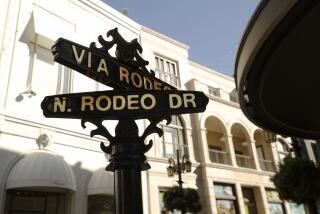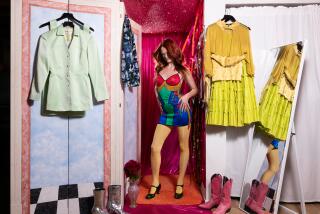Browsing the Memory Department
In the old days at the Bullocks Wilshire department store, customers weren’t customers. They were patrons. Women were ladies. And every sales check was handwritten, in order to prevent the ding of cash registers from disturbing the patrons.
“At other stores, you could use” cash registers, said Patricia Brown Thomson, who worked for the department store from 1950 to 1960. “But not at Bullocks Wilshire.”
Thomson returned to the department store Saturday for a rare glimpse inside and a trip down memory lane. The terra cotta and tile building, now used by Southwestern University School of Law as a library, is opened to the public once a year for a day of tours and lunch in the famous Tea Room.
While the tours attracted people interested in the building, its history and a chance to once again munch on coconut cream pie in the pastel-colored Tea Room, they also drew a group of loyal former employees who were brimming with stories of the old days, when movie stars roamed the store and young women modeled the latest fashions during lunch and tea.
Some of those former tea models, as they were known, were on hand Saturday, women in their 60s, 70s and 80s, their figures and posture still hinting at their former profession even after all these years. They greeted one another -- and the assembled former buyers and salespeople -- with hugs and squeals.
“You’re Joan Dineen,” Thomson said to a trim woman wearing a blue pantsuit and gold jewelry, who admitted that, yes, she was Joan -- although now she goes by Joan Mitchell.
“Holy Toledo,” said Thomson’s husband, Ron. “You haven’t changed a bit.”
Patricia Thomson sighed. “Those were the days.”
From the moment that the women stepped inside the old department store, though, hugs gave way to floods of memories -- and sometimes, tears.
Standing inside the building’s former Saddle Shop, where patrons once used a life-size plaster horse known as Bullocks Barney to test out new saddles, Mitchell told of her first fashion show, in 1947. She and the other models wore riding clothes, “from casual to sidesaddle. It was fabulous,” she said. “We wore top hats and veils.... We did it on the [building’s] play deck.”
Ivana Mooney, a former head model who worked at the department store from 1964 to 1978, told of another fashion show in which she and others wore crowns with lighted candles as they traipsed down the runway.
“They had the Fire Department waiting outside,” Mooney said. “I don’t know how we did it. We just did it.”
Christie Reed, the editor of an antiques collecting guide, listened intently to Mooney and the other former employees.
“I’m so glad we picked this tour,” said Reed, 28. “If I could go back in time.... “
When Bullocks Wilshire opened in 1929, it was one of only three commercial buildings, along with the Brown Derby and the Ambassador Hotel, in the mid-Wilshire area, said tour guide Carole Weiner, also the associate director of the law library. Before, she said, “everyone went downtown to do their shopping. But this was the area’s first suburban department store ... serving the nouveau riche of the city.”
The department store became the crown jewel of the Bullocks chain and remained so until Bullocks was acquired by R.H. Macy & Co. in 1988 and it became part of the I. Magnin chain. The store, once an exemplar of service and exclusivity, lost much of its business to suburban malls -- and, adding further insult, suffered millions in damage during the 1992 riots, when looters sacked the store, breaking every glass case on the first floor. In 1993, in the midst of bankruptcy, Macy’s announced that it was closing the store along with seven others in California.
After the law school bought the building in 1994, it spent almost a decade transforming it into a law library.
A technology-laden courtroom, once the Accessories Department, still displays the original lighting, detailed ironwork and clock.
Women’s Sportswear is now a reference room, the dressing rooms reinvented as librarians’ offices.
The transformation got mostly positive reviews from the former workers and the other members of the tour, many of whom remembered shopping there or eating in the Tea Room.
“It’s amazing what they’ve done,” said Mar Jennings of Brentwood. “They’ve kept it a tribute to the former Bullocks.”
Sylvia Johnson, who worked as a model and salesperson, looked around the French Room, the salon for the store’s wealthiest of clients, where clothing was expensive and exclusive. The Louis XIV-inspired salon, with its Lalique chandeliers and ornate furniture, is kept empty most of the time by the law library. She noticed the way the furniture was placed in the room and every detail registered in her memory. “It’s just amazing,” she said, “how they’ve changed it so.”
The 30 years she spent at the store, Johnson said, “were the best of my life.”
Ron Thomson, Patricia’s husband, likened “the camaraderie in the ladies who worked at Bullocks Wilshire” to that of soldiers who had fought in a war together.
“To me, it’s a fancy store,” he said. “But to them.... “ His voice trailed off, and he walked away, into another beautiful room of the old store.
More to Read
Sign up for The Wild
We’ll help you find the best places to hike, bike and run, as well as the perfect silent spots for meditation and yoga.
You may occasionally receive promotional content from the Los Angeles Times.






